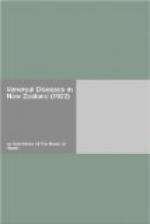The Committee regard the result obtained as furnishing some indication of the amount of active venereal disease existing in the Dominion. The Committee consider, however, that these figures must be considerably on the low side, for these reasons: (a) that a number of medical practitioners have not replied: (b) that some diseases attributable to venereal disease may not have been conclusively diagnosed as such, and, therefore, not included in the return. The return necessarily does not include cases, probably numerous, which have not been under medical care for some time, if at all; (c) to secure a complete return would have involved the keeping by each doctor of full records of all cases and a careful and laborious collation of figures.
With respect to the expression of opinion asked of medical practitioners upon the question “If venereal disease in this Dominion has or has not increased in a greater proportion than the population during the last five years,” it will be seen that of 322 who replied, 199 answered “Yes” and 203 “No.” This is necessarily purely a matter of impression, and it must also be borne in mind that the evidence shows that patients are now using the clinics in large numbers, while others who formerly went to general practitioners now consult specialists who have recently started in practice. On the other hand, it is possible there is a compensating influence in the fact that the public are being educated to the importance of seeking skilled medical treatment for these diseases.
(B.) Clinic Statistics.
A second source of information as to the prevalence of venereal diseases was provided by the statistics which have been compiled by the Department of Health as the result of the establishment of the venereal-diseases clinics. Among the appendices to this report will be found a return showing the number of persons attending at each of these clinics for the years 1920, 1921, and part of 1922, and recorded under the headings “Sexes” and “Diseases.” These statistics are valuable insomuch as they record facts, but with respect to the total prevalence they are but an indication, since they relate only to a small proportion of the population who have become infected and sought treatment. From this table (B) it will be found that the males attending for the first time represent 83.60 per cent. of the total, and females 16.40 per cent., or, roughly, a ratio of six males to every female.
Clinic Distribution.—In the figures for syphilis the following points are worthy of note: Auckland: A distinctly higher number of cases than the other centres. A marked drop in 1921 for males, but the return for this year indicates a rise; female cases show a rise for this year. Wellington: Returns appear fairly uniform, with a slight falling tendency, most marked in the females. Christchurch: A drop in male cases, with a fairly uniform rate of females. Dunedin: Here the rates appear uniform, with exception of a fall for males in 1922.




